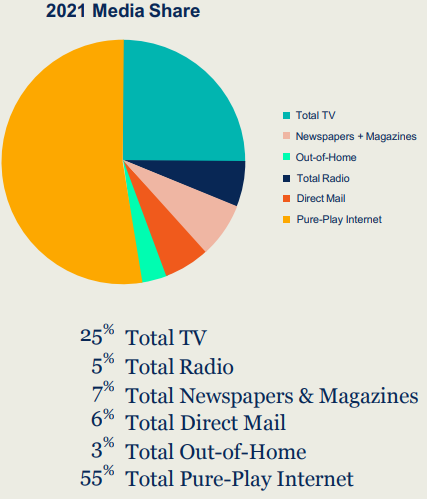Addressable and advanced television advertising that lets marketers reach target audiences with more personalized commercials is on the verge of becoming more mainstream on national TV networks. This convergence of linear and digital media underscores the need for interoperable and transparent ways of doing business.
“The TV industry is made up of hundreds, if not thousands, of different entities that are working together,” Tim Myers, general manager of strategy, products and partnerships at DISH Media, said in this interview with Beet.TV. “It’s always going to be complex, and because of that, you’re going to have to be flexible, and you’re going to have to have this interoperability.”
National TV ad spending will grow 6.6% next year as demand for media recovers, WPP’s GroupM forecast this month. It’s not clear how much of that spending will go into addressable ads, amid some of the uncertainties of the pandemic and implementing the technology to show different ads to different households on national broadcast TV.

Source: GroupM
For addressable advertising to grow and support continued investment, metrics that provide greater insights and transparency are a key part of a more open ecosystem.
“Working with others to drive that scale is very important in that open environment,” Myers said. “Being flexible to work with a variety of vendors, to be flexible in terms of the way the transactional models work and the services we can provide to programmers.”
While addressable advertising has been available for two minutes of every hour on cable and satellite TV, the inventory is going to expand to the other 14 minutes that programmers sell. That expansion will make addressable advertising more mainstream and bring greater scale.
“Addressable has been a great product that DISH and others have been able to drive through that first wave of scale, when it’s still been limited to the smaller portion of TV budgets,” Myers said. “We’d like to see addressable become the way that you transact television on an impression-based model.”
TV ratings company Nielsen this month announced plans to unify media measurement among linear and digital channels, a key step in encouraging advertisers to allocate their budgets more effectively and support further innovation.
“I’ve been talking about national enablement since I first started working on addressable,” Myers said. “The problem has always been for national networks, if you go to addressable … you’re only affecting a percentage of your overall footprint. You had to take that unit out of sale with Nielsen, and now the economics of trying to get back to what you could have sold that unit on a national basis always has been very difficult.”
More comprehensive metrics can help to make the market more open and transparent, supporting continued investment.
“The ability to have that inventory that you can still sell broadly, you can still transact with a Nielsen currency, but in the case where you’re going to take some of the audience out and transact that audience addressably — that’s critically important to make it so that programmers can optimize their inventory, and make much more of that inventory available for sale in an addressable model,” Myers said.
You are watching “An Open Ecosystem Is Key to Advanced TV Success,” a Beet.TV leadership series presented by Dish Media. For more videos, please visit this page.



































